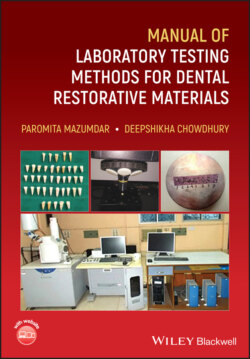Читать книгу Manual of Laboratory Testing Methods for Dental Restorative Materials - Paromita Mazumdar - Страница 7
Оглавление
Glossary of Key Terms
AbsorptionAbsorption of light takes place when matter captures electromagnetic radiation, converting the energy of photons to internal energy.Aerobic microbesmicroorganisms that can survive and grow in an oxygenated environment.AliquotA representative sample of a fixed proportion.Anerobic microbesmicroorganisms that do not require oxygen for growth. It may react negatively or die in the presence of oxygen.Assaythe testing of a material to determine its ingredients and quality.BiocompatibilityAbility of a material to elicit an appropriate biological response on a given application in the body. It is the quality of not having toxic or injurious effects on biological systems.Biofilmaggregate of microorganisms in which cells that are frequently embedded within a self produced matrix of extracellular polymeric substance adhere to each other and/or to the surface.CarcinogenicityThe ability or tendency of a substance to induce tumors (benign or malignant) and increase the malignancy.Commensalisma relationship between two organisms where one benefits but the other is neutral.Compressive StrengthMaximum stress a material can sustain under crush loading.Compressive StressCompressive force per unit area perpendicular to the direction of applied force.Contact angleAngle of intersection between a liquid and a surface of a solid that is measured from the solid surface through the liquid to the liquid/vapor tangent line originating at the terminus of the liquid/solid interface.Cyclic loadingRepeated or fluctuating application of forces in structural components.Cytotoxicitythe quality of being toxic to cells.Degree of conversionPercentage of carbon–carbon double bonds converted to carbon–carbon single bonds during curing to form a polymeric resin.DemineralisationLoss of minerals from the dental hard tooth tissues.Elastic Modulus (also modulus of elasticity and Young’s modulus)Stiffness of a material that is calculated as the ratio of elastic stress to elastic strain.Extraction ratioRatio of the surface area or mass of the test sample to the volume of the extractant used. It is used in biocompatibility testing of dental materials.Flexural strength (bending strength or modulus of rupture)Force per unit area at the instant of fracture in a test specimen subjected to flexural loading.Flexural stress (bending stress)Force per unit area of a material that is subjected to flexural loading.FlowRelative ability of a wax to plastically deform when it is heated slightly above body temperature.Fracture toughnessAbility of a material to absorb elastic energy and to deform plastically before fracturing; measured as the total area under a plot of tensile stress versus strain.Genotoxicitythe property of physical or chemical substances that damages the genetic information within a cell causing mutations, which may often lead to cancer.HardnessHardness is a measure of the resistance to localized plastic deformation induced by either mechanical indentation or abrasion.LABThe ‘L’ value for each scale indicates the level of light or dark, the ‘A’ value redness or greenness, and the ‘B’ value yellowness or blueness. All three values are required to completely describe an object’s color.Microfloracollective term for all microorganisms.MicroleakageThe flow of oral fluids and bacteria into the microscopic gap between a prepared tooth surface and a restorative material.MutagenicityThe property which induces mutations in an organism.Pathogenmicroorganism that causes disease.ReflectionReflection is the change in direction of a wavefront at an interface between two different media so that the wavefront returns into the medium from which it originated.RemineralizationReplacement of lost minerals from the dental hard tooth tissues.Saturationsaturation is the purity of a color. It is the color of an area judged in proportion to its brightness.Sensitivityability of a test to correctly identify those with the disease (true positive).Shear strengthShear stress at the point of fracture.Shear stressRatio of shear force to the original cross‐sectional area parallel to the direction of the applied force.Specificityability of a test to correctly identify those without the disease (true negative).Spectral reflectanceThe reflectance spectrum or spectral reflectance curve is the plot of the reflectance as a function of wavelength.Surface tensionA measurement of the cohesive energy present at an interface.Tensile strength (ultimate tensile strength)Tensile stress at the instant of fracture.Tensile stressRatio of tensile force to the original cross sectional area perpendicular to the direction of applied force.Teratogenicitycapacity of a substance to cause foetal abnormalities when administered during pregnancy.TransmissionTransmission of light is the moving of electromagnetic waves (whether visible light, radio waves, ultraviolet, etc.) through a material.Toxicityadverse effects that a chemical or physical agent may produce within a living organism.ViscosityResistance of a fluid to flow.
